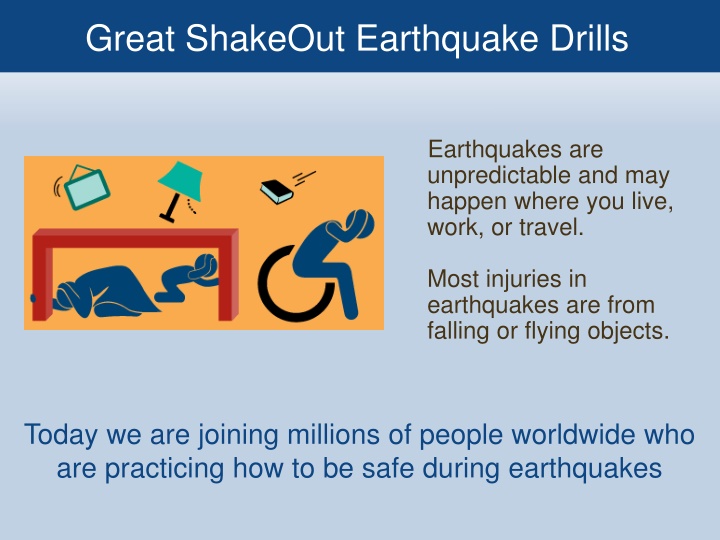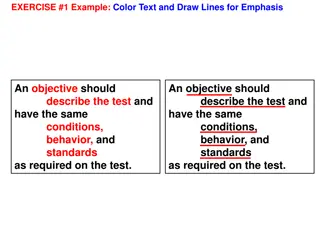
Prepare for Earthquakes: Safety Drills and Tips
Practice earthquake safety drills to stay safe during earthquakes at home, work, or travel. Learn how to Drop, Cover, and Hold On to protect yourself from falling objects. Check out discussion questions for emergency preparedness tips. Stay informed and be ready for any seismic activity.
Uploaded on | 11 Views
Download Presentation

Please find below an Image/Link to download the presentation.
The content on the website is provided AS IS for your information and personal use only. It may not be sold, licensed, or shared on other websites without obtaining consent from the author. If you encounter any issues during the download, it is possible that the publisher has removed the file from their server.
You are allowed to download the files provided on this website for personal or commercial use, subject to the condition that they are used lawfully. All files are the property of their respective owners.
The content on the website is provided AS IS for your information and personal use only. It may not be sold, licensed, or shared on other websites without obtaining consent from the author.
E N D
Presentation Transcript
Great ShakeOut Earthquake Drills Earthquakes are unpredictable and may happen where you live, work, or travel. Most injuries in earthquakes are from falling or flying objects. Today we are joining millions of people worldwide who are practicing how to be safe during earthquakes
What Are We About To Do? People get injured by falling objects and when they try to run, which is why we will practice Drop, Cover, and Hold On: In a CLASSROOM OR AUDITORIUM: Drop to the floor. Do not try to exit during shaking. Cover your head and neck with one hand and seek shelter under your desk or table as best as possible. If in an auditorium with no tables, take cover between the rows of chairs. Hold on to the leg of the desk/table with your other hand. In a LABORATORY: Step back from the lab table. Drop to the floor on your knees next to a wall, away from glass and other hazards if possible. Cover your head and neck with your hands and arms. Hold Onto something sturdy during the shaking Wait a Minute after shaking stops. Then look around for hazards, including behind you, before getting up. Carefully exit the building if instructed.
Time to ShakeOut! ShakeOut 60-second Drill Narration (Click to Play)
Discussion Questions 1. If you were at home during an earthquake, what might fall on you? Can you move those items or secure them so they won t cause injury? 1. Do you always keep your cell phone and computer charged? If you have a car, do you always keep the gas tank at least half full? 2. How would you contact your family in case of an emergency? Do you have a plan for checking in with one another and responding to emails/texts/etc.? 3. ATMs may be offline after a major earthquake. How long can you live on the money you have right now? 4. Do you know what check in services and hotlines are available for your use through our school? Learn more at www.earthquakecountry.org






















